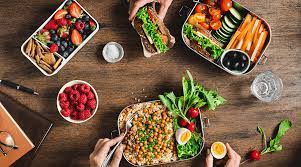“Nourishing Your Body and Soul: The Art of Crafting a Healthy Lunch”
Nourishing Your Body and Soul

Introduction:
It is impossible to emphasize how important a nutritious meal is in the hectic, fast-paced world of modern living. Beyond only filling our stomachs, lunch is an essential chance to replenish our energy, promote mental health, and establish a productive afternoon. We will dig into the concepts of mindful eating, balanced nutrition, and the joyous journey of nourishing body and spirit in this examination of the art of creating a nutritious lunch.
The Foundation: Building a Balanced Plate:
A well-balanced diet that includes a range of food types to supply vital nutrients is the cornerstone of any healthy meal. A well-rounded meal should consist of entire grains, fruits, vegetables, lean meats, and healthy fats. Our bodies are fueled by this harmonious combination of nutrients, which also promotes long-term vitality, sharper focus, and general wellbeing.
Protein Power: The Building Blocks of Health:
The building blocks of our bodies, proteins are essential for immune system function, satiety, and muscular growth. Lunchtime cravings may be avoided by including lean protein sources like quinoa, grilled chicken, fish, beans, or tofu. These foods offer you a steady supply of energy and encourage feeling full.
Whole Grains: Sustained Energy Release:
A nutritious lunch is anchored by whole grains, which deliver complex carbs which release energy gradually throughout the day. To enhance your meal, use nutrient-dense grains like bulgur, brown rice, quinoa, or whole wheat bread. These options supply vital fiber for digestive health in addition to providing sustained energy.
The Color Palette: Vibrant Fruits and Vegetables:
In addition to adding color and attractiveness to your lunch, a varied assortment of fruits and veggies also provides a variety of vitamins, minerals, and antioxidants. Try to arrange a variety of hues on your dish, such as vivid berries and citrus fruits, as well as leafy greens and red peppers. These organic powerhouses support immune system and general wellness.


Healthy Fats: The Art of Balance:
Even though the word “fat” may evoke negative feelings, healthy fats are a necessary part of a meal that is well-balanced. Add monounsaturated and polyunsaturated fat sources (avocado, nuts, seeds, and olive oil) to your diet to support healthy brain function, optimal nutrient absorption, and a pleasing taste profile.
Mindful Portions: Quality Over Quantity:
Portion control is essential while trying to have a nutritious lunch. It matters not just what you eat but also how much of it. By cultivating an awareness of your hunger and fullness cues, mindful eating enables you to enjoy every bite and refrain from overindulging. Aim for moderation and balance, emphasizing the quality of the meal above its amount.
Hydration: The Unsung Hero:
When solid food is the main emphasis, drinking enough water is frequently overlooked. Drinking enough water is essential for healthy digestion, nutritional absorption, and general wellbeing. To keep hydrated and invigorated, think about packing foods high in water, such as cucumber and watermelon, in your lunchbox. You should also develop the habit of drinking water throughout the day.
Meal Prepping: A Time-Saving Strategy:
We frequently go for quick, less nourishing solutions due to the hectic pace of everyday life. Meal prep is here to revolutionize everything. Weekly meal planning and preparation takes a little work, but it guarantees healthy choices, saves time, and lessens the temptation to choose less healthful options.
Culinary Creativity: Flavorful and Fun:
Eating healthfully never has to mean being tasteless or uninteresting. Take advantage of this chance to get creative with your lunches by experimenting with different herbs, spices, and healthy foods. To keep your meals interesting and fulfilling for your palate, include a variety of flavors, textures, and cuisines.
Superfood Superstars: Boosting Nutritional Density:
Superfoods are nutrient-dense, high-benefit foods that may make great lunchtime complements. To increase the nutritional density of your dish, think about adding components like salmon, chia seeds, greens, or blueberries. These superfood superstars are loaded with antioxidants, vitamins, and minerals.


Conclusion:
Making a nutritious lunch involves more than just ingesting calories; it’s a comprehensive process. It’s about adopting a way of living that places an emphasis on health, balance, and nourishment. Let the art of preparing a nutritious lunch be a conscious and delectable adventure as we negotiate the pressures of our everyday life. Let it be a celebration of bright tastes, nutritional wisdom, and the pure joy of nurturing body and spirit.





